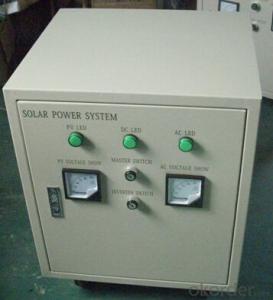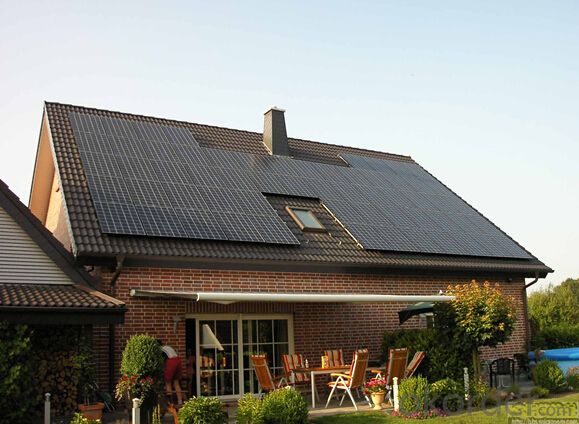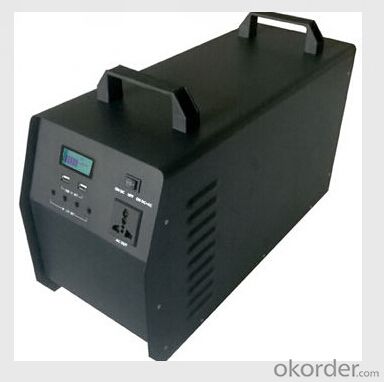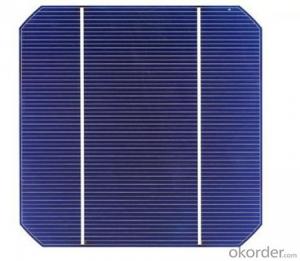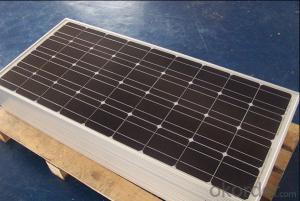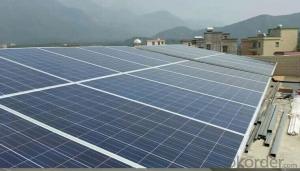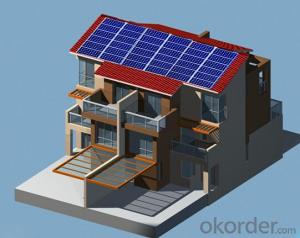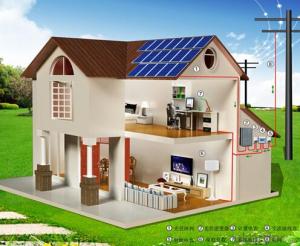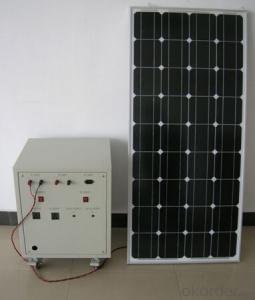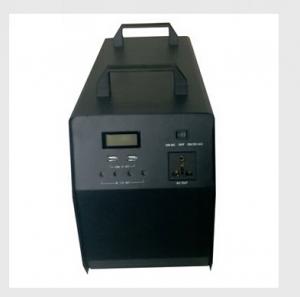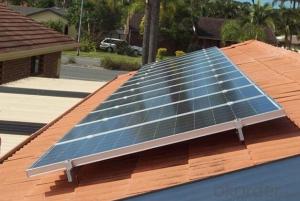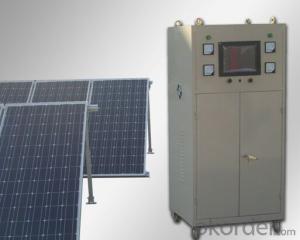Xtj Prime Solar Cells CNBM Solar Roof Solar System 12000W Popular in Africa
- Loading Port:
- Shanghai
- Payment Terms:
- TT OR LC
- Min Order Qty:
- 1 PCS
- Supply Capability:
- 3000 PCS/month
OKorder Service Pledge
OKorder Financial Service
You Might Also Like
Introduction of Solar Home System
The basic PV or solar cell typically produces only a small amount of power. To produce more power, solar cells (about 40) can be interconnected to form panels or modules. PV modules range in output from 10 to 300 Watts. If more power is needed, several modules can be installed on a building or at ground-level in a rack to form a PV array.
In addition to solar cells, a typical PV module or solar panel consists of these components:
A transparent top surface, usually glass
An encapsulant -- usually thin sheets of ethyl vinyl acetate that hold together the top surface, solar cells, and rear surface
A rear layer -- a thin polymer sheet, typically Tedlar, that prevents the ingress of water and gases
A frame around the outer edge, typically aluminum.
Energy performance ratings for PV modules include the following:
Peak Watt -- Measures the maximum power of a module under laboratory conditions of relatively high light level, favorable air mass, and low cell temperature. These conditions are not typical in the real world.
Normal operating cell temperature -- Measures a module's nominal operating cell temperature after the module first equilibrates with a specified ambient temperature. It results in a lower Watt value than the peak-Watt rating, but it is probably more realistic.
AMPM Standard -- Measures the performance of a solar module under more realistic operating conditions. It considers the whole day rather than "peak" sunshine hours, based on the description of a standard solar global-average day (or a practical global average) in terms of light levels, ambient temperature, and air mass.
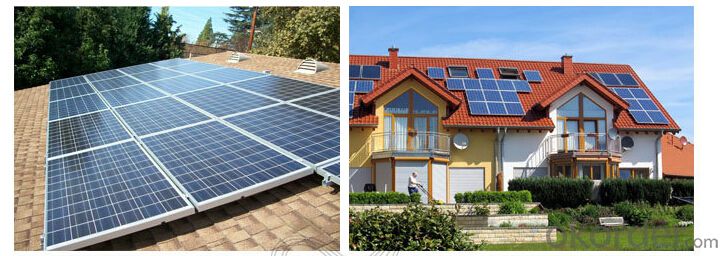


Working Principle of Solar Roof System
The stand alone Solar Home System is an off-grid solar system which uses batteries to store the solar energy. Stand alone solar system solutions design for those who are not able or willing to connect to electricity grid.
Specification of Solar Home System
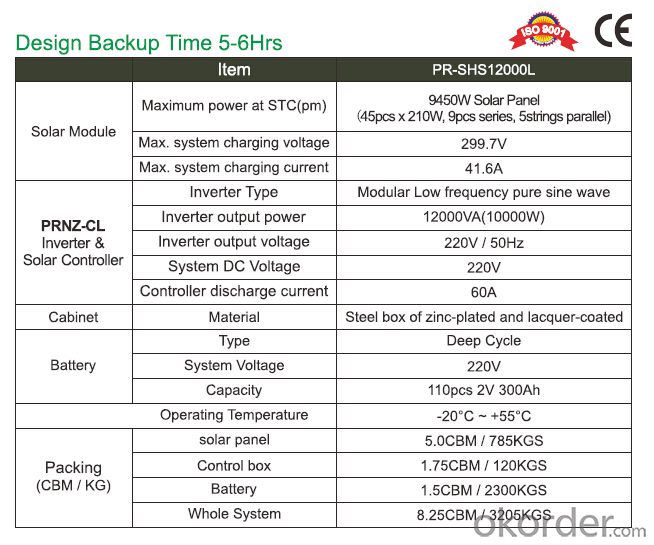
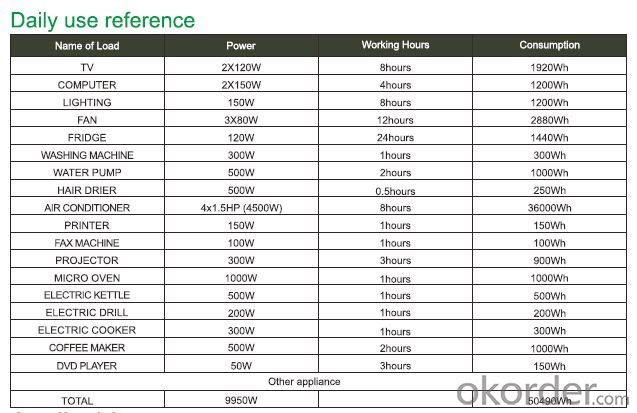
Product Features of Solar Home System
1. Off grid solar power system is mainly used for application with relatively-small power consumption, and the areas have no grid network coverage, or grid power is unstable or outage condition.
2. It’s composed of solar panels, hybrid solar inverter, battery bank, solar panel mounting racks, and other accessories required fora complete home solar power system.
3. The battery bank gives a stable power output to the solar inverter which converts DC to AC to power loads, and provides power backup in rainy or cloudy days.
4. The solar panels generate electricity at daytime and charge the battery bank.
5. The off grid home solar power system provides grid power bypass in case of battery power shortage when sunshine is not enough.
6. All the off grid home solar power system configurations are worked out by scientific calculation and design.
Advantage of Our Solar Home System
1 Excellent Performance: Our Solar Home System is composed by Brand Standard Kits with high quality. Our solar system has the advantage of high efficiency and stable operation. We can ensure our product with a long life period.
2. Small Orders Accepted: We can accept small orders as our customer’s trial order.
3. Warehouse: We have warehouse overseas which can bring great convenience to our customer to pick up the products.
Terms and Conditions
1. Trade terms: FOB Shanghai
2. Payment terms: 30% T/T, balanced before shipment/ LC at sight before shipment. Actual Terms can be negotiated for big order.
3. Package: Exported standard package suitable for tough handling and sea transport.
4. Delivery: Goods to be ready within 10~30 days depending on order quantity.
5. Warranty: 10 years for solar panel, 2 years for controller/inverter/battery.
FAQ
Q: Could you introduce the background of your company?
A: We are a Group corp. with 1GW capacity in China, which is Okorder’s registered VIP Supplier, possess Financial Service from Okorder.com.
Q: Required mainly certificates (CE&IEC/TUV/RoHS)?
A: Our products are certificated by CE RoHS, IEC, ISO, TUV, UL etc.
Q: Your main exported market is?
A: Main markets of our products is: South-east Asia, Mid-east, Arica, East Europe and Latin America.
- Q: Can solar cells be used in mountainous regions?
- Yes, solar cells can be used in mountainous regions. While mountainous regions may have varying weather conditions and shading from surrounding peaks, solar panels can still generate electricity from sunlight. However, the efficiency of solar cells may vary depending on factors like orientation, tilt angle, and the amount of direct sunlight received. It is crucial to carefully design and install solar systems in mountainous areas to optimize their performance and take advantage of the available sunlight.
- Q: Which one is better on the solar cells panel? The Monocrystal Solar Energy Cell or photovoltaic cell?
- The Monocrystal Solar Energy Cell and photovoltaic cells both has its advantage and disadvantage, so it really depends on what you use them for.
- Q: What is the role of solar cell inverters in grid-tied systems?
- The role of solar cell inverters in grid-tied systems is to convert the direct current (DC) energy generated by solar panels into alternating current (AC) energy that is compatible with the electrical grid. These inverters ensure that the solar energy produced by the panels can be used to power appliances and devices in homes or businesses, and any excess energy can be fed back into the grid for others to use. Additionally, solar cell inverters also provide important safety features, such as isolating the solar system from the grid during power outages to protect utility workers.
- Q: Can solar cells be installed on sloped surfaces?
- Yes, solar cells can be installed on sloped surfaces. In fact, sloped surfaces can often be advantageous for solar panel installation as they allow for better sun exposure and increased energy generation.
- Q: Can solar cells be used in desert regions?
- Yes, solar cells can be used in desert regions. In fact, desert regions are ideal for solar energy generation due to their high levels of solar radiation and clear skies. The availability of ample sunlight and vast open spaces make deserts well-suited for large-scale solar power installations, such as solar farms or concentrated solar power plants. Additionally, the arid climate in deserts minimizes the risk of cloud cover or rain interfering with solar energy production.
- Q: Solar water heater plate can be directly converted into electrical energy?
- solar controller: the role of solar controller is to control the working state of the entire system, and the battery played a charge protection, over discharge protection role in the larger temperature difference, the qualified controller should also have the temperature Compensation function. Other additional functions such as light control switch, time control switch should be the option of the controller;
- Q: What is the role of tracking systems in solar cell installations?
- The role of tracking systems in solar cell installations is to optimize the efficiency and output of the solar panels by automatically adjusting their position and orientation throughout the day to maximize exposure to sunlight. This ensures that the panels are always facing the sun at the optimal angle, resulting in increased energy production and improved overall performance of the solar cell installation.
- Q: Can solar cells be used in powering RVs and campers?
- Yes, solar cells can be used in powering RVs and campers. Solar panels installed on the roof of an RV or camper can convert sunlight into electricity, which can then be used to power various appliances, lights, and charging systems. This allows for a sustainable and self-sufficient power source while on the road or camping in remote locations.
- Q: How do solar cells impact global warming?
- Solar cells have a positive impact on global warming as they generate electricity by harnessing the sun's energy, reducing the reliance on fossil fuels. By producing clean and renewable energy, solar cells help to mitigate greenhouse gas emissions, thereby reducing the overall contribution to global warming.
- Q: What is the role of charge controllers in solar cell systems?
- The role of charge controllers in solar cell systems is to regulate and optimize the charging process of the batteries connected to the solar panels. They monitor the voltage and current levels from the panels and ensure that the batteries are charged efficiently and safely. Charge controllers also protect the batteries from overcharging, over-discharging, and other potential damage, ultimately extending their lifespan.
Send your message to us
Xtj Prime Solar Cells CNBM Solar Roof Solar System 12000W Popular in Africa
- Loading Port:
- Shanghai
- Payment Terms:
- TT OR LC
- Min Order Qty:
- 1 PCS
- Supply Capability:
- 3000 PCS/month
OKorder Service Pledge
OKorder Financial Service
Similar products
Hot products
Hot Searches
Related keywords
